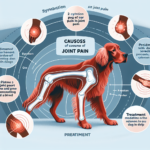Gordon Setter Joint Pain: Causes, Symptoms, Prevention, and Treatment

Introduction
The Gordon Setter is a distinguished and elegant breed known for its striking black and tan coat, intelligence, and loyal nature. Originating from Scotland, this breed was developed in the 17th century by the Duke of Gordon for hunting game birds. Gordon Setters are renowned for their endurance, keen sense of smell, and ability to work in challenging terrains. They are medium to large-sized dogs, typically weighing between 45 to 80 pounds, and are characterized by their muscular build and graceful movement.
Like many purebred dogs, Gordon Setters are prone to certain health issues. Among these, joint pain is a significant concern that can affect their quality of life. Joint pain in dogs can stem from various conditions, including hip dysplasia, arthritis, and elbow dysplasia. Understanding the causes, symptoms, prevention, and treatment of joint pain in Gordon Setters is crucial for ensuring their well-being and longevity.
Joint health is particularly important for Gordon Setters due to their active lifestyle and working heritage. These dogs require regular exercise to maintain their physical and mental health, making joint issues a potential hindrance to their overall happiness and functionality. By addressing joint health proactively, owners can help their Gordon Setters lead active, pain-free lives.
Breed-Specific Joint Pain Risks
Genetic Predisposition
Gordon Setters, like many other breeds, have a genetic predisposition to certain joint-related issues. Hip dysplasia is a common hereditary condition in this breed, where the hip joint does not fit properly into the hip socket, leading to pain and arthritis over time. Elbow dysplasia, another genetic condition, involves abnormal development of the elbow joint, causing lameness and discomfort. Arthritis, a degenerative joint disease, can also be prevalent in Gordon Setters, particularly as they age.
Age-Related Risks
As Gordon Setters age, the risk of developing joint pain increases. Senior dogs are more susceptible to arthritis and other degenerative joint conditions. Typically, signs of joint pain may start to appear in Gordon Setters around the age of 7 or 8, although this can vary depending on the individual dog’s genetics and lifestyle. Early detection and management are key to mitigating the impact of age-related joint issues.
Activity Level and Joint Stress
Gordon Setters are known for their high energy levels and need for regular exercise. While their active nature is beneficial for their overall health, it can also contribute to joint stress, particularly if they engage in high-impact activities such as running, jumping, or rough play. Working Gordon Setters, used in hunting or field trials, may be at an even higher risk due to the physical demands of their tasks. It’s essential to balance their exercise regimen to prevent overexertion and joint strain.
Common Symptoms of Joint Pain in Gordon Setters
General Symptoms
Owners should be vigilant for common symptoms of joint pain in their Gordon Setters, which may include:
- Limping: A noticeable limp or favoring one leg over another.
- Stiffness: Difficulty in getting up or lying down, especially after rest.
- Reluctance to Move: Hesitation or refusal to engage in physical activities they once enjoyed.
- Swelling: Visible swelling around the joints.
- Behavioral Changes: Increased irritability or signs of discomfort when touched.
Breed-Specific Symptoms
In Gordon Setters, joint pain may manifest in specific ways due to their size and build. Owners might notice a decrease in their dog’s endurance during activities or a reluctance to climb stairs or jump into vehicles. Additionally, the breed’s expressive nature may make it easier to detect subtle changes in behavior or movement that indicate discomfort.
When to Consult a Vet
If any of the above symptoms are observed, it is crucial to consult a veterinarian promptly. Early intervention can prevent the progression of joint issues and improve the dog’s quality of life. Regular veterinary check-ups are also essential for monitoring joint health and catching any problems early.
Preventive Measures for Joint Health
Exercise Recommendations
Maintaining an appropriate exercise routine is vital for Gordon Setters. Low-impact activities such as walking, swimming, and controlled play are excellent for keeping their joints healthy without causing excessive stress. Avoiding high-impact activities like jumping or running on hard surfaces can help prevent joint injuries. Consistent, moderate exercise is key to maintaining muscle strength and joint flexibility.
Dietary Suggestions
A balanced diet rich in essential nutrients supports joint health. Foods containing glucosamine and chondroitin can help maintain cartilage health, while omega-3 fatty acids have anti-inflammatory properties that benefit joints. Owners may consider supplements specifically designed for joint health, but it’s important to consult a veterinarian before adding any new supplements to the dog’s diet.
Weight Management
Maintaining a healthy weight is crucial for reducing joint stress in Gordon Setters. Excess weight puts additional pressure on the joints, exacerbating pain and discomfort. Owners should monitor their dog’s weight and adjust their diet and exercise routine as needed to keep them within a healthy weight range. Regular weigh-ins and body condition assessments can help ensure the dog remains fit and healthy.
Early Screening and Monitoring
Early screening for joint issues can make a significant difference in managing and preventing joint pain. Regular veterinary check-ups should include assessments of joint health, particularly for breeds like Gordon Setters that are predisposed to joint problems. Diagnostic tools such as X-rays or joint fluid analysis can help detect issues early, allowing for timely intervention and treatment.
Treatment Options for Joint Pain
Non-Surgical Treatments
Non-surgical treatments are often the first line of defense against joint pain in Gordon Setters. These may include:
- Medications: Anti-inflammatory drugs, pain relievers, and joint supplements can help manage pain and inflammation.
- Physical Therapy: Exercises and therapies designed to improve joint function and reduce pain.
- Lifestyle Adjustments: Modifying the dog’s activity level and environment to reduce joint stress.
Surgical Options
In severe cases, surgical intervention may be necessary to alleviate joint pain. Common surgical options for Gordon Setters include:
- Hip Replacement: Replacing the damaged hip joint with an artificial one.
- Arthroscopy: A minimally invasive procedure to clean out the joint and remove damaged tissue.
- Osteotomy: Cutting and realigning bones to improve joint function.
Surgery should be considered after thorough consultation with a veterinarian and evaluation of the dog’s overall health and quality of life.
Alternative Therapies
Alternative therapies can complement traditional treatments and provide additional relief for joint pain. These may include:
- Acupuncture: Using fine needles to stimulate specific points on the body to relieve pain.
- Hydrotherapy: Water-based exercises that reduce joint stress while improving strength and mobility.
- Massage: Therapeutic massage to improve circulation and reduce muscle tension around the joints.
Lifestyle and Management Tips
Daily Care Routine
A consistent daily care routine can help manage joint pain in Gordon Setters. This may include:
- Regular, low-impact exercise such as walking or swimming.
- Administering prescribed medications and supplements.
- Providing a balanced diet tailored to joint health.
- Monitoring the dog’s weight and adjusting their diet as needed.
Modifying the Home Environment
Making the home environment more comfortable for a dog with joint pain can significantly improve their quality of life. Consider the following modifications:
- Installing ramps or steps to help the dog access furniture or vehicles.
- Providing orthopedic beds that offer better support for joints.
- Ensuring food and water bowls are at a comfortable height to reduce strain.
Long-Term Management
Long-term management of joint pain involves ongoing monitoring and adjustments to the dog’s care routine. Regular veterinary check-ups, maintaining a healthy weight, and providing appropriate exercise are essential components. Owners should also be attentive to any changes in their dog’s behavior or mobility and seek veterinary advice as needed.
FAQs About Gordon Setters and Joint Pain
What are the early signs of joint pain in Gordon Setters?
Early signs of joint pain in Gordon Setters include limping, stiffness, reluctance to move, and behavioral changes such as irritability or discomfort when touched.
Can joint pain in Gordon Setters be prevented?
While genetic predispositions cannot be entirely prevented, maintaining a healthy weight, providing appropriate exercise, and regular veterinary check-ups can help manage and reduce the risk of joint pain.
Are there specific diets that can help with joint health in Gordon Setters?
Yes, diets rich in glucosamine, chondroitin, and omega-3 fatty acids can support joint health. Consult with a veterinarian for specific dietary recommendations and supplements.
When should I consider surgery for my Gordon Setter’s joint pain?
Surgery should be considered if non-surgical treatments are ineffective and the dog’s quality of life is significantly impacted. A thorough evaluation by a veterinarian is necessary to determine the best course of action.
What alternative therapies are effective for managing joint pain in Gordon Setters?
Alternative therapies such as acupuncture, hydrotherapy, and massage can complement traditional treatments and provide additional relief for joint pain.
Conclusion
Joint pain is a common concern for Gordon Setters, but with proactive care and management, owners can help their dogs lead active, pain-free lives. Understanding the causes, symptoms, prevention, and treatment options is essential for maintaining joint health. Regular veterinary check-ups, appropriate exercise, a balanced diet, and weight management are key components of joint care. By taking these preventive measures and consulting with a veterinarian regularly, owners can ensure their Gordon Setters enjoy a high quality of life.



